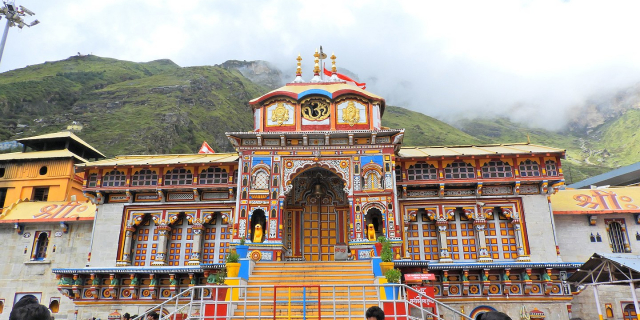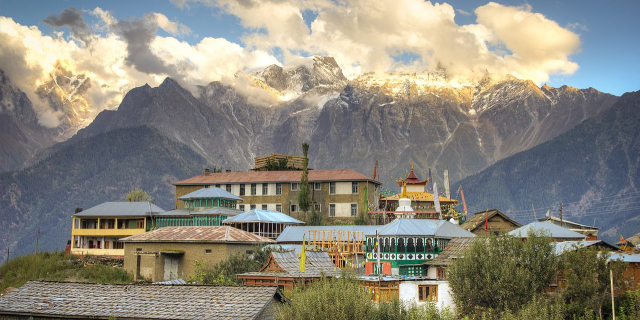Valley of Flowers National Park is an Indian national park which was established in 1982. It is located in Chamoli in the state of Uttarakhand and is known for its meadows of endemic alpine flowers and the variety of flora. This richly diverse area is also home to rare and endangered animals, including the Asiatic black bear, snow leopard, musk deer, brown bear, red fox and blue sheep. Birds found in the park include Himalayan monal pheasant and other high altitude birds.
At 3352 to 3658 meters above sea level, the gentle landscape of the Valley of Flowers National Park complements the rugged mountain wilderness of Nanda Devi National Park to the east. Together, they encompass a unique transition zone between the mountain ranges of the Zanskar and Great Himalayas. The park stretches over an expanse of 87.50 km2 and it is about 8 km long and 2 km wide. The park lies completely in the temperate alpine zone. Both parks are encompas...Read more
Valley of Flowers National Park is an Indian national park which was established in 1982. It is located in Chamoli in the state of Uttarakhand and is known for its meadows of endemic alpine flowers and the variety of flora. This richly diverse area is also home to rare and endangered animals, including the Asiatic black bear, snow leopard, musk deer, brown bear, red fox and blue sheep. Birds found in the park include Himalayan monal pheasant and other high altitude birds.
At 3352 to 3658 meters above sea level, the gentle landscape of the Valley of Flowers National Park complements the rugged mountain wilderness of Nanda Devi National Park to the east. Together, they encompass a unique transition zone between the mountain ranges of the Zanskar and Great Himalayas. The park stretches over an expanse of 87.50 km2 and it is about 8 km long and 2 km wide. The park lies completely in the temperate alpine zone. Both parks are encompassed in the Nanda Devi Biosphere Reserve (223,674 ha) which is further surrounded by a buffer zone (5,148.57 km2). Nanda Devi National Park Reserve is in the UNESCO World Network of Biosphere Reserves.
The park is open only during summer from June to October and it is covered by heavy snow for the rest of the year.
 Lady Joan Margaret Legge's memorial grave.Documented explorers
Lady Joan Margaret Legge's memorial grave.Documented explorers
The place was little known to the outside world due to its inaccessibility. In 1931, Frank S. Smythe, Eric Shipton and R. L. Holdsworth, all British mountaineers, lost their way while returning from a successful expedition to Mt.Kamet and happened upon the valley, which was full of flowers. They were attracted to the beauty of the area and named it the "Valley of Flowers." Frank Smythe later authored a book of the same name.[1]
In 1939, Lady Joan Margaret Legge, (21 February 1885 – 4 July 1939) a botanist deputed by the Royal Botanic Gardens, Kew,[2] arrived at the valley to study flowers and while traversing some rocky slopes to collect flowers, she slipped off and died.[3] Her sister later visited the valley and erected a memorial near the spot.[4]
Prof. Chandra Prakash Kala, a botanist deputed by the Wildlife Institute of India, carried out a research study on the floristics and conservation of the valley for a decade, beginning in 1993.[5] He made an inventory of 520 alpine plants exclusively growing in this national park and authored two important books – "The Valley of Flowers – Myth and Reality" and "Ecology and Conservation of the Valley of Flowers National Park, Garhwal Himalaya.[5][6]
Timeline1862: The Pushpawati River Valley was discovered by Col. Edmund Smyth;
1931: The valley visited by the climber Frank S. Smythe who wrote a book publicising the "Valley of Flowers";
1934: The upper Nanda Devi Sanctuary was reached and described by mountaineers Eric Shipton & Bill Tilman;
1936: Mountaineers Bill Tilman & Noel Odell climbed Nanda Devi;
1939: The basin established as the Nanda Devi Game Sanctuary by Government Order 1493/XIV- 28 of 7/01;
1962: Border disputes closed the area to traffic, altering the local economy;
1974–82: The sanctuary was opened to mountaineering, but the ensuing degradation led to its closure to all users;
1980: The park was established as Sanjay Gandhi National Park by Notification 3912/ XIV 3-35-80; grazing and mountaineering stopped;
1980: The Valley of Flowers was declared a national park by Government Order 4278/XIV-3-66-80 under the provisions of the Wildlife Protection Act of 1972, for the conservation of its flora;
1982: The park was renamed Nanda Devi National Park;
1988: The Nanda Devi National Biosphere Reserve established (223,674 ha) with the national park as core zone (62,462 ha) and a 514,857 ha buffer area surrounding both sites; restrictions were imposed on the rights of nearby villagers. Inscribed as a UNESCO World Heritage site;[7]
2000: The Biosphere Reserve extended by the government to 586,069 ha and the Valley of Flowers National Park was added as the second core zone (62,462 ha+ 8,750 ha, totalling core areas of 71,212 ha);
2004: The two core zones and buffer zone designated a UNESCO MAB reserve.



























Add new comment